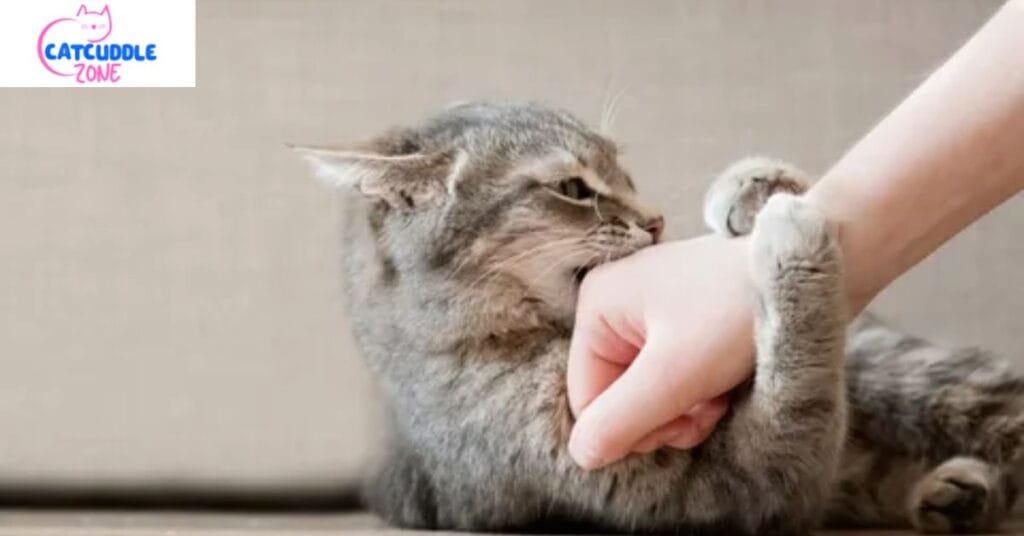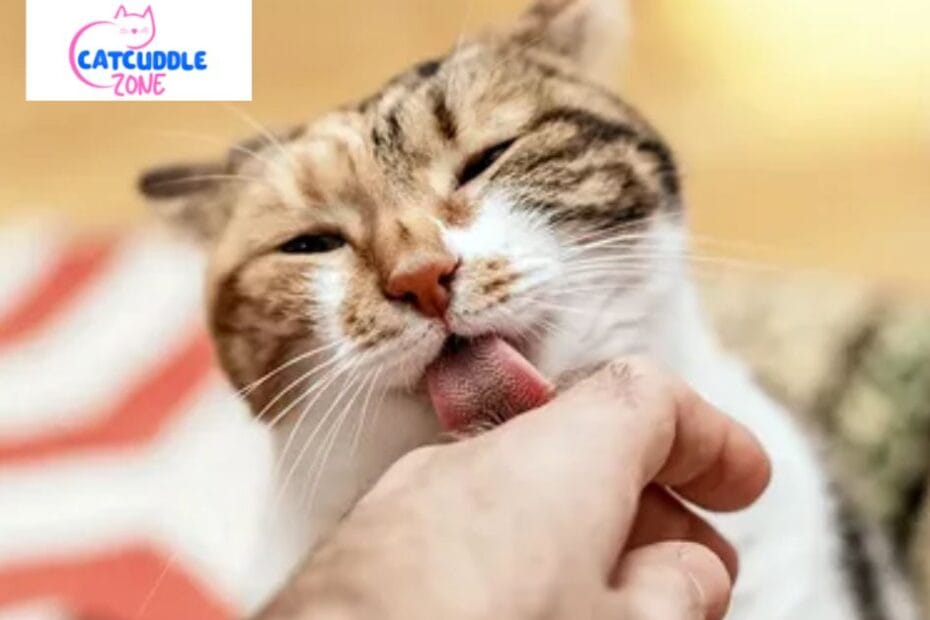Ever wondered why does my cat bite me then lick me? This curious mix of affection and nip often leaves owners puzzled. It’s part of unique cat licking and biting behavior rooted in instinct, playfulness, and even stress. Sometimes it’s a gentle cat love bite showing trust, while other times it hints at overstimulation in cats or a playful mood.
By watching cat body language, you’ll start to understand if it’s love, a playful tease, or your cat asking for a break. This guide will help explain these surprising habits and what they really mean.
Understanding This Strange Cat Behavior
Cats use actions, not words. When you see cat licking then biting meaning, your cat is trying to talk to you. They might be showing love, asking you to stop, or wanting to play. Cat body language is subtle. Watching your cat’s ears, tail, and whiskers helps you understand them better.
Sometimes a cat will lick, then gently nip. This is called a cat love bite. It may hurt a bit but it’s rarely meant to harm. Think of it as your cat’s way of saying, “I like you.” Cats often groom each other the same way, mixing licks with small bites.
Natural Instincts and Evolutionary Reasons
Cats are natural hunters. Cat hunting instincts are strong, even in indoor cats. In the wild, cats lick and bite prey as part of catching and cleaning it. So, your cat may repeat these cat grooming habits on you, mixing love and instinct.
Another reason comes from dominance. Dominance in cats can look like licking followed by biting. It’s rarely aggression but more like your cat saying, “I’m the boss now.” Cats also show love and bond this way, copying how mothers groom kittens.
Signs Your Cat is Being Playful vs. Aggressive
It’s key to see if your cat is playing or getting upset. Look at cat body language. Playful cats keep ears up, tails swish gently, and eyes look relaxed. An aggressive or fearful cat flattens ears, shows big pupils, and might growl.
Playful biting is light and quick. Aggressive biting is harder and the body looks stiff. Notice fearful cat behavior and signs of cat discomfort like low growls or a twitching tail. That helps know when to step back and avoid stress.
Overstimulation: When Affection Turns Into Biting
Cats love attention, but too much can annoy them. This is called overstimulation in cats or petting-induced aggression. You may pet a cat too long, then it turns to bite. That’s your cat’s way of saying, “Enough.”
To avoid this, watch for signs your cat has had enough petting: fast tail flicks, skin rippling, or sudden stiffness. Each cat has an overstimulation threshold in cats. Learn it by stopping before they get annoyed. Respect helps build trust.
Affection and Love Bites: What They Really Mean
Ever wondered, what is a cat love bite? It feels sudden, but it’s sweet. Cats groom owners by licking and biting softly. This means deep trust. It’s a special way cats show care, much like a gentle pinch between close friends.
These cat affection signs may not feel gentle to us, but they are normal. Cats also do this when they want you to stop petting or give more love. It’s their way of saying, “I care, but let’s change things up.”

Stress and Anxiety: Could Your Cat Be Uncomfortable?
Sometimes, licking and biting means stress. Look for cat stressed signs like hiding, less eating, or obsessive licking. Loud sounds, strangers, or changes at home cause cat stress and anxiety.
Help by creating a cat-friendly environment. Use calming cat beds, cat hideaways, or soft blankets. These spots make cats feel safe. For severe stress, ask your vet about solutions to help calming anxious cats.
Does the Order Matter: Bite First or Lick First?
Some cats bite then lick. Others lick then bite. Does it mean something different? In truth, no. Cat biting as communication and cat licking as affection both share feelings. The order matters less than the context.
Watch understanding cat signals and your cat’s posture. A relaxed cat giving gentle bites and licks shows love. A stiff, tense cat with hard bites shows stress. The message is clearer in body language than in order.
Why Your Cat Might Bite You But Not Others
You might ask, “Why does my cat lick me then bite me but not my partner?” Cats bond differently. Scent, touch, and daily routines all matter. Cats may see you as “their person” and use these signs only with you.
Also, how you pet can matter. Some people pet softly, others roughly. Cats react to each style. Your cat may be saying “slow down” to you but feels calmer with someone else. It’s about trust, mood, and habit.
What to Do If Your Cat Bites Aggressively
Aggressive biting can scare you. Handling aggressive cats needs calm. Never shout or hit. Instead, pause and step back. Think about what caused the bite. Too much petting? Loud sound? Pain?
If aggression is new, see a vet to check for pain. Create a calm space with calming cat beds or cat hideaways. Use positive reinforcement for cats. Give treats when your cat stays calm. Reward calm behavior, not biting.
Tips to Stop Your Cat From Biting and Licking
To reduce biting, keep play sessions short. Use cat toys for playtime so your cat bites toys, not you. Watch body language and stop before your cat feels annoyed. Keep hands away during rough play.
Give daily play with wands, balls, and tunnels. Offer hiding spots and quiet time. Cats love routine. A safe, cat-friendly environment lowers stress. Use treats and praise to reward calmness. Over time, your cat learns better ways to show love.
Case Study Table: Real Cats & Their Behaviors
| Cat’s Name | Action | Likely Meaning |
| Tiger | Licks then gentle bites | Cat asking for attention |
| Misty | Bites after long petting | Petting-induced aggression |
| Luna | Licks then bites toys | Cat wants to play signals |
| Max | Bites first, then licks | Cat biting as communication |
Final Thoughts
Cats mix biting and licking to talk to us. It shows love, asks for space, or sometimes signals stress. Watch cat body language and learn your cat’s habits. By reading these signs, you build trust and keep your cat happy.
Still asking, why does my cat bite me then lick me? Know it’s often love, sometimes play, and sometimes stress. With patience, toys, calm places, and love, your bond with your cat only grows deeper. And remember: each gentle bite means you matter to them.
(FAQs)
Why does my cat bite me then lick me afterwards?
It’s often your cat’s quirky way of mixing affection and play, or showing they’re overstimulated after petting.
Should I let my cat lick and bite me?
Gentle cat love bites are normal, but stop interaction if biting turns rough to avoid encouraging aggressive play.
Why is my cat affectionate and then attacks me?
This usually means your cat has reached their overstimulation threshold and wants the petting to end.
Do cats lick to show dominance?
Sometimes, yes—cat licking as affection can shift into nibbling to test boundaries or assert mild dominance in cats.
